
Lesson Twenty-six: Spokane's Expo '74; A World's Fair for the Environment
Logo for Spokane's Expo '74 (right)
One way to measure changing attitudes toward growth and natural resources in the Pacific Northwest during the 1960s and 1970s is to contrast the international expositions in Spokane in 1974 and Seattle in 1962. When the people of Seattle hosted a world's fair, they meant for it both to celebrate their recent economic and demographic expansion and to perpetuate that expansion (with the one caveat that the outward sprawl of population should not detract too much from the financial position of the central business district). They demonstrated little concern about the environmental problems caused by the growth that they coveted. Perhaps typical of the ecological sentiment of the Century 21 Exposition were the remarks of William Merry, editor of the Washington Motorist, who admitted that, while growth had its costs, it was an inevitable sort of improvement: "Seattle does want new pathways to progress, though it may well be true that a heavy influx of people will threaten the very things that bring them here—the great untouched, undefiled, unspoiled outdoors. Seattle knows in its heart that things cannot always remain the same." In this formulation, growth was seen as an unquestioned good, an end in itself.
Growth in the Pacific Northwest had been regarded in this fashion for more than a century, since American settlers arrived in the 1830s and 1840s and set about trying to impose their own agendas, their own economic designs, on territory claimed by Great Britain and the Hudson's Bay Company. For the next twelve or thirteen decades—with the brief exception of times of economic downturn such as in the mid-1880s and the 1930s—the overriding impulse of the great majority of Americans in the region had been to accelerate the rate of growth, mainly by developing closer ties to sources of capital and immigrants and closer ties to markets around the world, and by exploiting natural resources. Growth had long been viewed as the main solution to many of the problems of the Pacific Northwest, particularly the matter of its hinterland or colonial status in relation to the eastern states and California. Growth became a central aspect of Americans' identity in the Pacific Northwest. It motivated efforts to recruit more settlers in order to offset British influence during the 1840s; loomed as the key benefit to be gained from a variety of federal programs (such as the Donation Land Act, the movement of native peoples off their homelands and on to reservations, the subsidy for building the Northern Pacific Railroad, and the underwriting of the costs of building dams in the Columbia Basin); and stood as the main thing being celebrated by the first world's fairs in the Northwest, at Portland in 1905 and Seattle in 1909. Growth slowed in the years after World War One, but the national crises after 1929—the Great Depression, World War Two, and the Cold War—created a framework for sustained additional growth. This mid-20th-century burst of expansion contributed to the confidence that permeated the 1962 Seattle World's Fair.
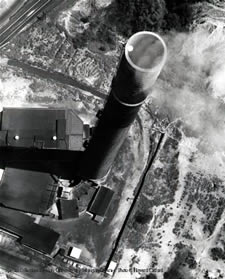
The American Northwest long identified its future and its character with growth which, in the economic sphere, revolved largely around the exploitation of natural resources until developments after 1929 encouraged the rise of new kinds of industry. The region was widely seen as a kind of "promised land." Only a few people defined the region's promise in terms other than those involving growth; some utopians and socialists, for example, had between 1885 and 1917 imagined the Northwest as the American place most amenable to their radical visions for remaking U.S. society. But the majority of Americans, and particularly the male-dominated, economic and political elites who governed Northwest society, generally measured the fulfillment of the region's promise in such quantitative terms as the amount of wealth generated, the amount of resources extracted, and the amount of population increase. When these amounts expanded, when growth occurred, the Pacific Northwest was seen as living up to its promise. This formula for determining success or failure in the region generally prevailed through the 1950s. In the 1960s and 1970s, however, it encountered a challenge from a different way of thinking. This way of thinking was not entirely new, but its increasing influence was something different.
Tacoma's ASARCO Smelter (left), while in operation, was a symbol of both economic growth and environmental pollution. (Special Collections, University of Washington. Photo by Howard Clifford.) The Cascade Range (below). A view on the southern edge of the North Cascades National Wilderness. (Special Collections, University of Washington.)
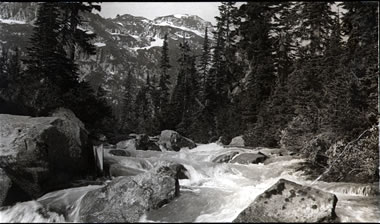
During the 1880s and 1890s, at the same time that socialists and utopians had imagined a different kind of Pacific Northwest, a new measure of fulfillment began to emerge slowly in the region and around the country, one focused more on qualitative rather than quantitative criteria and one that paid greater attention than before to the environment. Helen Hunt Jackson, writing about Puget Sound in 1883, had foreshadowed this new calculus. By the same token, in the 1890s the conservation and preservation movements emerged in the Pacific Northwest, spearheaded by the federal government which created forest reserves and national parks in the Cascade Mountains. Succeeding generations of progressive and New-Deal reformers, operating at the municipal and state levels as well as at the federal level, elaborated on earlier efforts by devising programs to conserve and preserve natural resources (such as creating state and city park systems, setting aside federal wilderness areas, and encouraging replanting of cut-over forests).
Then, in the late 1950s, 1960s, and 1970s, the environmental movement began to crest. Nationally, some of the landmarks of the movement were the successful fight to prevent construction of the Echo Park Dam on the Green River, along the Utah-Colorado border, in the mid-1950s; passage of the Wilderness Act of 1964 and the Endangered Species Act of 1973; creation of the U.S. Environmental Protection Agency in 1969; and celebration of the first Earth Day in 1970. In Washington state, some of the landmarks of the movement were the creation of Metro in Seattle and King County in 1958 to clean up Lake Washington; the creation of the North Cascades National Park complex in 1968 and the Columbia River Gorge National Scenic Area in 1986; and cancellation of federal support, based in part on environmental concerns, for Boeing's Supersonic Transport project in 1971. [A fascinating look at the debates over preservation vs. use of western lands and rivers, with a long section on North Cascades, is John McPhee, Encounters with the Archdruid (New York: Farrar, Straus, and Giroux, 1971). The "archdruid" is wilderness advocate David Brower.] In Oregon, the movement crested with the election of Tom McCall as governor in 1967 and the campaign to prevent in-migration of Californians to the state during the 1970s. McCall gave voice to the new way of looking at the Northwest in 1973 by suggesting that quantitative and qualitative measurements of "success" in the Northwest might, in some circumstances, be mutually exclusive: "Unlimited and unregulated growth leads inexorably to a lowered quality of life." Most Northwesterners were not yet prepared, of course, to renounce growth altogether, so they spoke instead about "regulating" or "managing" or "limiting" it. But as an ethos for regional society, growth was questioned more sharply than ever before.
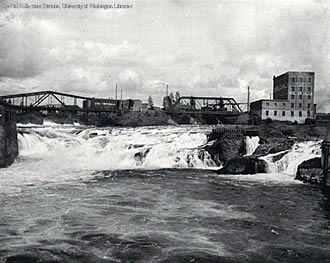
Just as new concerns about the environment were calling into question old assumptions about growth, the city of Spokane decided to sponsor a world's fair. Expo '74, as the event was called, reflected the rising attention being paid to ecological matters. The motto of the fair was "Celebrating Tomorrow's Fresh New Environment," and the exhibits staged during the fair's six-month run gave expression to the environmental issues under discussion during the early 1970s. On the day the fair opened, May 7, 1974, the city released 1974 trout into the Spokane River in order to demonstrate the fact that it had been cleaned up enough to support fish life. Symposia at the fair pondered environmental issues, and many of the 5.2 million visitors came away with new thoughts about the state of the earth. [The most thorough work on Spokane's fair is J. William T. Youngs, The Fair and the Falls: Spokane's Expo '74, Transforming an American Environment (Cheney: Eastern Washington University Press, 1996).] But Expo '74 proved in many ways an ambivalent statement about the environment, for at least two major reasons—because the region and nation remained uncertain about how to strike a balance between pursuing growth and attaining environmental quality, and because the host city was reluctant to embrace the environmental message.
Falls on the Spokane River (left). (Special Collections, University of Washington).
Spokane was a curious place to hold an environmental world's fair. The basis for the city's fortunes had long been the extractive industries of the Inland Empire—mining, logging, farming, and hydropower—and this kind of economy does not immediately lend itself to the kind of environmental questioning that took place at Expo '74. Over the years Spokane's civic leaders acquired a fairly conservative reputation, which again would suggest less than eager support for the environmental movement afoot during the late 1960s and early 1970s. So how did the environment get chosen as the fair's main message? Outside consultants advised the planners of Expo '74 that a fair "themed on the world's environmental problems and highlighting the history and ecology of Spokane and the northwest region" would be popular with visitors. In other words, the environmental theme would sell; it would attract people and attention to a fairly remote place. Moreover, Spokane's civic leaders could link the environmental theme to their more narrow urban objective, redevelopment of lands near the downtown core, which they portrayed as an ecological restoration project. Of course, their redevelopment plans stemmed more from wanting to protect downtown property values than from wanting to protect nature, but the fair nonetheless produced a new city park, a cleaned-up river, and a spruced-up downtown.
The Spokane River and downtown Spokane, 1953 (right).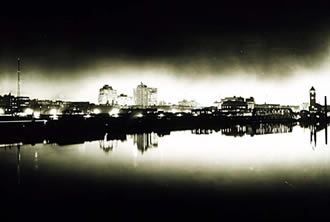
In hosting a fair as a downtown renewal project, the civic leaders of Spokane followed the example of Seattle. And because Spokane's fairgrounds were actually adjacent to the downtown core, rather than one mile distant, they enjoyed considerably more success in getting the fair to influence downtown. But success was a long time in coming. Concerns about downtown dated back to the early 1950s, even before Seattle came up with the idea for a fair. Expo '74 occupied 100 acres. Half of these consisted of the Spokane River and Falls; the other half was land bordering the river and downtown. The 100 acres stood where three different rail lines had been built through the city, and where industry, rail yards, and low-rent residential housing had grown up around the tracks. The congestion of trestles, bridges, stations, warehouses, and transient quarters was so bad, according to local legend, that some residents of Spokane did not even know that a river ran through the center of the city.
After World War II this riverfront area deteriorated, and so did the neighboring Central Business District (CBD). Property values fell, vacancy rates increased, and buildings became dilapidated. Downtown retail and traffic volumes declined as new malls in outlying parts of the city lured away customers and businesses with their plentiful free parking, proximity to new housing subdivisions, and newer stores and offices. When Sears, Roebuck decided to move from downtown to the North Town Shopping Center in 1958, downtown property owners and city government organized into a group called Spokane Unlimited to redevelop the CBD. After about a decade of trying, Spokane Unlimited decided in the late 1960s to stage an event of such proportions that it would mobilize the entire community in support of their downtown plans, and attract investment from the outside. Thus was born Expo '74. It was perhaps audacious of Spokane, a relatively remote and small city of 180,000, to host a world's fair, but the exposition did attract outside interest and money (from the state and federal government and from private firms), cleaned up the riverfront, and rejuvenated downtown.
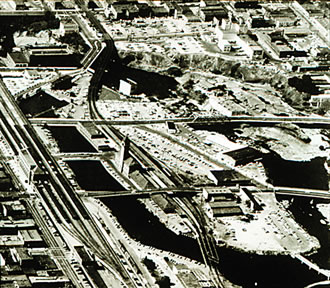
Fair Site, 1960 (left). The future Expo `74 site in the 1960s was a complex of railroad yards, industry, and parking areas.
In succeeding at urban renewal, Expo '74 lived up to the environmental theme at the local level. However, at a larger scale fair officials did not always take the theme of ecology seriously. They tried to stress upbeat rather than gloomy or complicated messages about ecology-largely because they did not want to discourage visitors-and as planning progressed they increasingly emphasized entertainment at the expense of education and controversy. Most environmental groups were discouraged from full-scale participation, but big companies and state and foreign governments, who were better prepared to invest money in the fair and thus in Spokane, were well-represented. Thus the Soviet Union participated, despite its own abysmal record of pollution, and expressed a Marxist-Leninist message about the environment that favored the manipulation rather than the protection of nature, confident that humans could manage nature better than nature itself could. The "surest way to safeguard the biosphere," one spokesperson explained, "lies not through passive 'protection,' but through the intelligent and scientifically-substantiated use of natural resources." (The Soviets did take opportunities to criticize the U.S. environmental record. A Russian journalist commented on the B-52 bombers continually flying in and out of nearby Fairchild Air Force Base: "It is a great irony. An environment fair down here and the thing that destroyed the environment of Vietnam up there.")
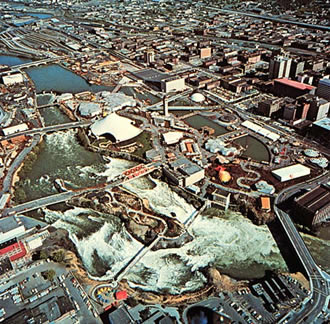
The 1974 Fair: Expo `74 (left) covered 100 acres of land directly adjacent to downtown Spokane.
Many other participants took equal liberties with the environmental theme. The Mormon Church addressed "moral pollution" more than environmental pollution. President Nixon opened the fair with remarks that stressed foreign policy ("a new environment of peace for all nations") and prosperity (an "environment" of high employment and ample energy). Nixon's critics, concerned about the growing Watergate scandal, protested his appearance with a sign that read, "Clean Up Our Environment—Impeach Nixon." Corporate exhibitors, of course, took the most liberties. The Energy Pavilion at Expo '74 was sponsored by oil, coal, electric, and nuclear power companies, not a group eager to address matters of conservation. Similarly, the Agriculture Pavilion was hosted by agribusiness, chemical, petroleum, and food-processing firms, hardly the entities most concerned about the effects of modern agriculture on ecosystems and public health. The Ford Motor Company epitomized the corporate response to the environmental movement at Expo '74: it featured recreational vehicles which permitted consumers to come into closer (not to mention more destructive) contact with nature. Moreover, Ford very explicitly stated that environmental protection must not come at the expense of Americans' standard of living. "We in industry know the average American is truly interested in a clean environment, but...not...to the exclusion of his job or an adequate supply of gasoline...or heating oil for his house or concern over the rising cost of living." (The remarks reflected American concerns in the early 1970s about an energy shortage.) In other words, concern about the environment was fine, so long as it did not compromise American affluence, comfort, and economic growth. Ford's views mirrored fairly well the view of the Spokane officials responsible for Expo '74. Once the fair was over, downtown boosters deemed it an economic and redevelopment success, and emphasized its contributions to growth by making downtown Spokane "a better place in which to do business."
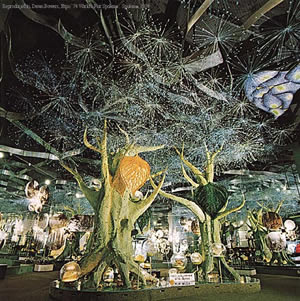
This abstract forest was part of the Soviet Pavilion (right). According to the commemorative booklet for the fair, the display was used to explain biological relation ships. (In Dawn Bowers, Expo `74 World's Fair Spokane. Spokane, 1974. p.64.)
Naturally, this approach to environmental issues sparked controversy. Local environmental groups had early on questioned the idea of a world's fair. First, they worried about its impact on the local environment. Maybe, they said, Spokane did not need the added traffic and pollution that the exposition would attract. The local chapter of Zero Population Growth predicted that the exposition would diminish the city's quality of life, and passed out bumper stickers that read "Expollution '74." One wag even suggested that "the ideal world's fair in honor of the environment would be no world's fair at all." Second, environmental activists charged that Expo '74 presented primarily commercial and "Disneyfied" messages about the environment. The business leadership behind the fair, they complained, cared only about Spokane's economic growth and downtown property values, and did not really want serious discussion about environmental issues—particularly if that discussion suggested that Americans might need to alter their lifestyle or reduce their consumption in order to safeguard nature. Third, environmental groups felt that Expo '74 had made their active participation prohibitively expensive, so many boycotted or protested the fair. On July 4, fifteen demonstrators burned an Expo '74 flag, which they had marked with a dollar sign ($). While being arrested they declared that "This is the Environmental World's Farce" and chanted "Exploit '74." It was clear that the downtown leadership behind Expo '74 did not represent the entire city when it came to environmental issues.
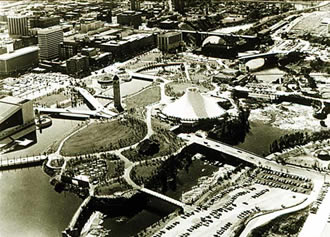
The theme and controversy at Spokane's world's fair made it clear that there was a growing awareness of environmental problems in the United States and around the world. Naturally, however, there was in 1974—still an early time in the "greening of America"—no widespread agreement about the size of or solutions to those problems. Even today, environmental issues seldom generate consensus. This may be particularly true in the Pacific Northwest, a region that had for so long identified itself with economic and demographic growth-rooted especially in extraction of natural resources-that it would be very difficult to reject the old ethos quickly and adopt a new one. Expo '74 suggested that the region had not moved very far down the road to ecological enlightenment. Yet, the environmental theme of the Spokane world's fair and the controversy it generated in fact represented a considerable departure from Seattle's Century 21 Exposition, a dozen years before.
After the Fair (left): Riverfront Park, a cleaner Spokane River, and a renewed downtown were some of the legacies of Expo `74.
| Course Home | Previous Lesson | Next Lesson |